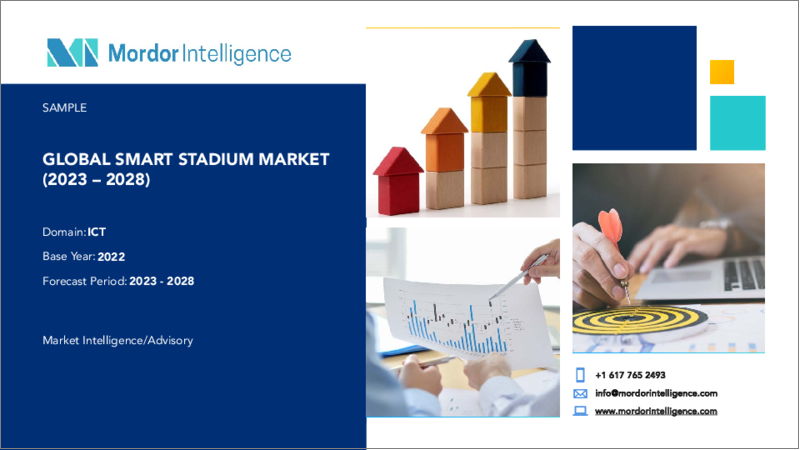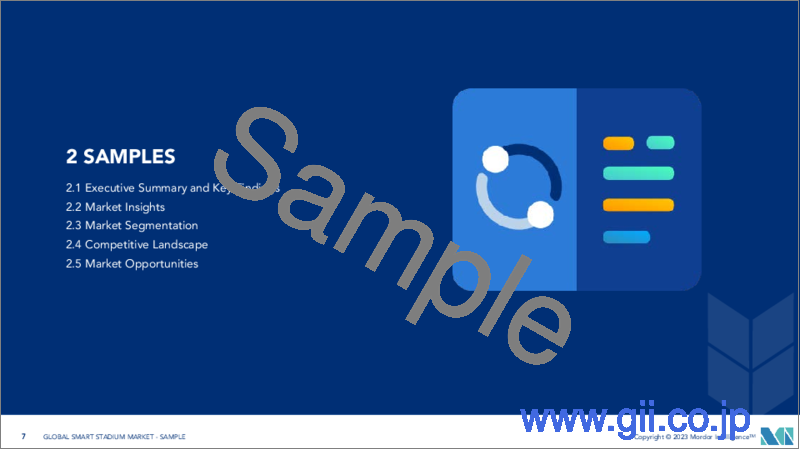|
|
市場調査レポート
商品コード
1198382
スマートスタジアム市場- 成長、動向、予測(2023年~2028年)Smart Stadium Market - Growth, Trends, and Forecasts (2023 - 2028) |
||||||
|
● お客様のご希望に応じて、既存データの加工や未掲載情報(例:国別セグメント)の追加などの対応が可能です。 詳細はお問い合わせください。 |
|||||||
| スマートスタジアム市場- 成長、動向、予測(2023年~2028年) |
|
出版日: 2023年01月23日
発行: Mordor Intelligence
ページ情報: 英文 120 Pages
納期: 2~3営業日
|
- 全表示
- 概要
- 目次
スマートスタジアム市場は、2020年に68億米ドルとなり、予測期間(2021年~2026年)にCAGR21.53%を記録し、2025年には182億3000万米ドルに達すると予測されます。
スタジアムが完全にデジタル化される動向が、スマートスタジアム市場の牽引役となります。
主なハイライト
- スタジアムを訪れるファンは、より直感的な体験を期待しており、開催国も複合施設の投資収益率(ROI)を高めるための新たな方法を模索しています。そのため、スタジアムやアリーナは今や、競技力、競合、大勢の観客のための家であるだけでなく、技術の進歩を見せるための手段でもあるのです。
- 技術の進歩に伴い、消費者はモバイル機器での最新情報や統計を好むようになり、スタジアムは収益化、スタジアムの満員化、ファンの支出増加のための新たな方法を見出すようになりました。スタジアムからクラウド自体の映像を見ることもできますし、アリーナを直接ソーシャルメディアに配信することも可能です。
- 世界中で開催されるスポーツイベントの増加に伴い、人々は試合をライブで観戦し、その後テレビで見る傾向があり、これがスマートスタジアム市場を牽引しています。
- スマートスタジアム市場の大きな課題は、アップグレードのための初期投資の高さと、投資回収の不確実性であろう。
スマートスタジアム市場の動向
世界のスポーツイベント数の増加がスマートスタジアム市場の成長を牽引
- 過去数年間、スポーツイベントの需要は増加しており、主にスポンサーシップの増加とチケットの低価格化によって後押しされています。収容人数の多いスタジアムでは、多くのスポーツ愛好家がライブで試合を観戦しています。
- 以前は、チケットは開催国や近隣の国に限られていました。スポーツイベントの需要が高まっているため、スタジアムのスポンサーは安価な旅行を手配し、海外のファンも納得のいく費用で好きな試合を観戦できるようにしています。
- 例えば、ドイツはスポーツの盛んな国であり、サッカー、ブンデスリーガなどでは、スタジアムが満員になることもあります。このため、スタジアムへの入場者数が多くなり、予測期間中の市場成長を後押しするものと思われます。
欧州がスマートスタジアム市場を独占
- 欧州は、スマートスタジアム市場で最大のシェアを占めています。そのため、この地域の国々は、群衆をよりよく管理し、効果的なネットワークと接続性を可能にするためにIoTソリューションの導入に投資しています。テクノロジーとスポーツは、スポーツ産業の発展を成功させるための完璧な組み合わせです。この2つの要素が、試合の観客体験をより良くするために、満員のスタジアムがデジタル化されつつある理由なのです。
- クラブ・アトレティコ・デ・マドリードのワンダ・メトロポリタン・スタジアムは、欧州で最もスマートなスタジアムの一つです。スタジアム全体には1500の無線LANポイント、6000のネットワークコンセントがあり、観客は携帯電話から駐車スペースや自分の席を知ることができます。スマートフォンを使ってクラウドにアクセスし、試合のライブ映像をその場で携帯電話だけで見ることができるのです。
- 欧州政府は、より多くのスタジアムをスマートスタジアム化するためのスマートプロジェクトに取り組んでいます。スマートスタジアムの統合に関連した研究開発、イノベーション、政策要件が行われており、予測期間中のスマートスタジアム市場の原動力となります。
その他の特典。
- エクセル形式の市場予測(ME)シート
- 3ヶ月間のアナリストサポート
目次
第1章 イントロダクション
- 調査の成果
- 調査の前提
- 本調査範囲
第2章 調査手法
第3章 エグゼクティブサマリー
第4章 市場力学
- 市場概要
- 市場促進要因と抑制要因のイントロダクション
- 市場促進要因
- スポーツイベントの増加
- 市場抑制要因
- 初期投資の高さ
- バリューチェーン/サプライチェーン分析
- 業界の魅力- ポーターのファイブフォース分析
- 新規参入業者の脅威
- 買い手/消費者の交渉力
- 供給企業の交渉力
- 代替品の脅威
- 競争企業間の敵対関係
第5章 市場セグメンテーション
- 地域別
- 北米
- 欧州
- アジア太平洋地域
- 世界のその他の地域
第6章 競合情勢
- 企業プロファイル
- IBM Corporation
- Intel Corporation
- Schneider Electric SE
- Huawei Technologies Co Ltd
- Cisco Systems Inc.
- Johnson Controls International PLC
- CenturyLink Inc.
- Honeywell International Inc
- Aruba Networks(Hewlett Packard Enterprise)
- John Mezzalingua Associates LLC
- Vix IP Pty Ltd
- NXP Semiconductors NV
- AllGoVision Technologies Pvt Ltd
第7章 投資分析
第8章 市場機会と将来動向
The smart stadium market was valued at USD 6.8 billion in 2020 and is expected to register a CAGR of 21.53% during the forecast period (2021 - 2026) to reach USD 18.23 billion by 2025. The trend of stadiums getting completely digital will drive the smart stadium market.
Key Highlights
- Fans who visit the stadiums are expecting a more intuitive experience and the host countries are also looking for new ways to increase the return on investment (ROI) on their complex. Therefore, stadiums and arenas are now not only a house for athletic prowess, competition, and large audiences; they are a vehicle for showcasing technological advancements.
- Consumers with technological advancements prefer updates and stats on their mobile devices, leading stadiums to find newer ways to monetize, fill the stadium, and compel the fans to increase expenditure. They can watch the video from the cloud itself from the stadium, and can also broadcast the arena directly to social media.
- With the growing number of sports events happening around the world, people tend to watch the game live, then watch it on TV which is driving the smart stadium market.
- The major challenge for the smart stadium market would be the high initial investment to upgrade and the uncertainty in return of investments.
Smart Stadium Market Trends
Increasing Number of Sports Events Globally Drive the Smart Stadium Market Growth
- The demand for sporting events has increased over the past few years and primarily being encouraged owing to the rising number of sponsorships and low ticket pricing. With the high capacity stadiums, large numbers of sports enthusiast go to watch the game live at the stadium.
- Earlier, the tickets were kept limited to the host and neighboring countries. Since the demand for live sporting events is increasing, stadium sponsors are making cheaper travel arrangements and easing overseas fans to attend their favorite match at a compelling cost.
- For instance, Germany is famous for its sports activities, more precisely for football, the Bundesliga League, and others for which the stadiums are usually jam-packed. This is encouraging and bringing a high entry of attendees to the stadium, which is likely to boost the market growth over the forecast period.
Europe to Dominate the Smart Stadium Market
- Europe holds the maximum share in the smart stadium market. Therefore, the countries in the region are investing in adopting IoT solutions to manage the crowd better and enable effective network and connectivity. Technology and sports are the perfect combination of successful development in the sports industry. These two elements are the reason why the full stadiums are being transformed into digitalization for better spectator experience of the match.
- The Wanda Metropolitan Stadium of Club Atletico de Madrid is one the smartest stadiums in Europe. The whole stadium has 1500 wifi points, 6000 network outlets, and the spectators can know about the parking spaces as well as their seats from the mobile itself. They can use their smartphones and access to cloud and watch the live video of the match then and there itself on their phone only.
- The European government has undertaken smart projects to convert more and more stadiums into smart stadiums. R&D, innovation, and policy requirements related to smart stadiums integration are taking place, which will drive the smart stadium market in the forecast period.
Smart Stadium Market Competitor Analysis
The major players include IBM Corporation, Huawei Technologies Co. Ltd, Intel Corporation, NTT Communications Corporation, Schneider Electric SE, NXP Semiconductors N.V., Tech Mahindra Limited, Cisco Systems Inc., Johnson Controls International PLC, among others. Since the market is driven by these major players, it is consolidated and therefore the market concentration will be high.
- November 2018 - Huawei introduced its digital platform based on providing new ICT, including artificial intelligence (AI), Internet of Things (IoT), Big Data, and cloud, hence enabling city-wide intelligence and sustainable development across the international smart city industry.
- January 2018 - IBM launched a platform approach to data science offering, such as hybrid data management, unified integration and governance platform, and data science and business analytics platform, which will comprise data cleaning as a crucial step, thereby widening the consumer base.
Additional Benefits:
- The market estimate (ME) sheet in Excel format
- 3 months of analyst support
TABLE OF CONTENTS
1 INTRODUCTION
- 1.1 Study Deliverables
- 1.2 Study Assumptions
- 1.3 Scope of the Study
2 RESEARCH METHODOLOGY
3 EXECUTIVE SUMMARY
4 MARKET DYNAMICS
- 4.1 Market Overview
- 4.2 Introduction to Market Drivers and Restraints
- 4.3 Market Drivers
- 4.3.1 Growing Number of Sports Events
- 4.4 Market Restraints
- 4.4.1 Higher Initial Investments
- 4.5 Value Chain / Supply Chain Analysis
- 4.6 Industry Attractiveness - Porter's Five Forces Analysis
- 4.6.1 Threat of New Entrants
- 4.6.2 Bargaining Power of Buyers/Consumers
- 4.6.3 Bargaining Power of Suppliers
- 4.6.4 Threat of Substitute Products
- 4.6.5 Intensity of Competitive Rivalry
5 MARKET SEGMENTATION
- 5.1 Geography
- 5.1.1 North America
- 5.1.2 Europe
- 5.1.3 Asia-Pacific
- 5.1.4 Rest of the World
6 COMPETITIVE LANDSCAPE
- 6.1 Company Profiles
- 6.1.1 IBM Corporation
- 6.1.2 Intel Corporation
- 6.1.3 Schneider Electric SE
- 6.1.4 Huawei Technologies Co Ltd
- 6.1.5 Cisco Systems Inc.
- 6.1.6 Johnson Controls International PLC
- 6.1.7 CenturyLink Inc.
- 6.1.8 Honeywell International Inc
- 6.1.9 Aruba Networks (Hewlett Packard Enterprise)
- 6.1.10 John Mezzalingua Associates LLC
- 6.1.11 Vix IP Pty Ltd
- 6.1.12 NXP Semiconductors NV
- 6.1.13 AllGoVision Technologies Pvt Ltd




